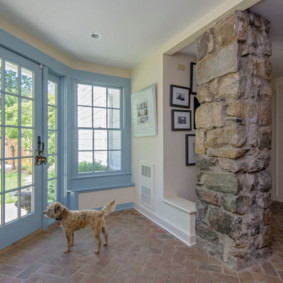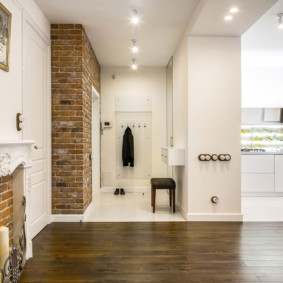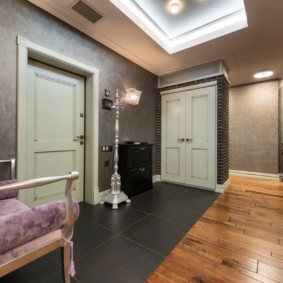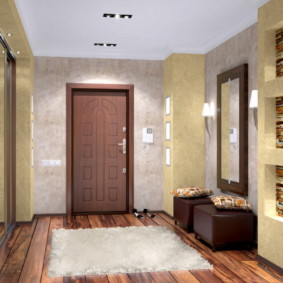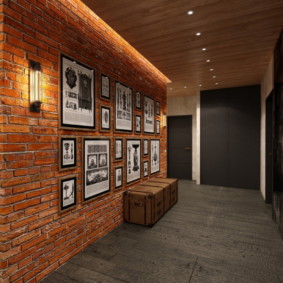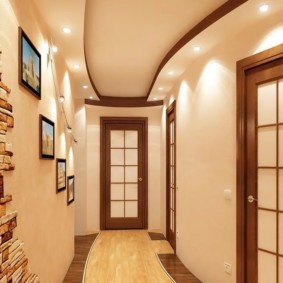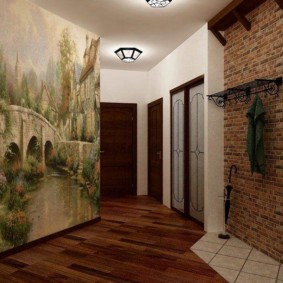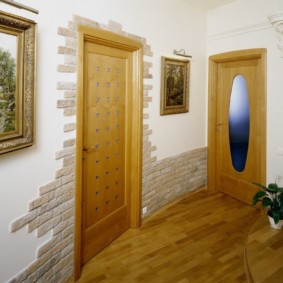 Hallway
Stylish design of the hall in the house and apartment: useful design tips
Hallway
Stylish design of the hall in the house and apartment: useful design tips
Often, repairs in the hallway cause a lot of questions and controversial situations. It would seem that this is not a kitchen where everything obeys the demands of a demanding housewife, and not a living room, from which comfort is expected for guests and hosts. But the hallway creates the first impression of your home, so we'll talk about the finishing work in this room.

In order for the hearth to always please with its original appearance, it is necessary to pay great attention to the design of the hallway.
Decorative rock
Content
Decoration of the hallway with decorative stone and wallpaper is becoming increasingly popular. First of all, because it is practical, and besides this, a decorative stone very often looks no worse than a natural one and the corridor acquires a creative look.
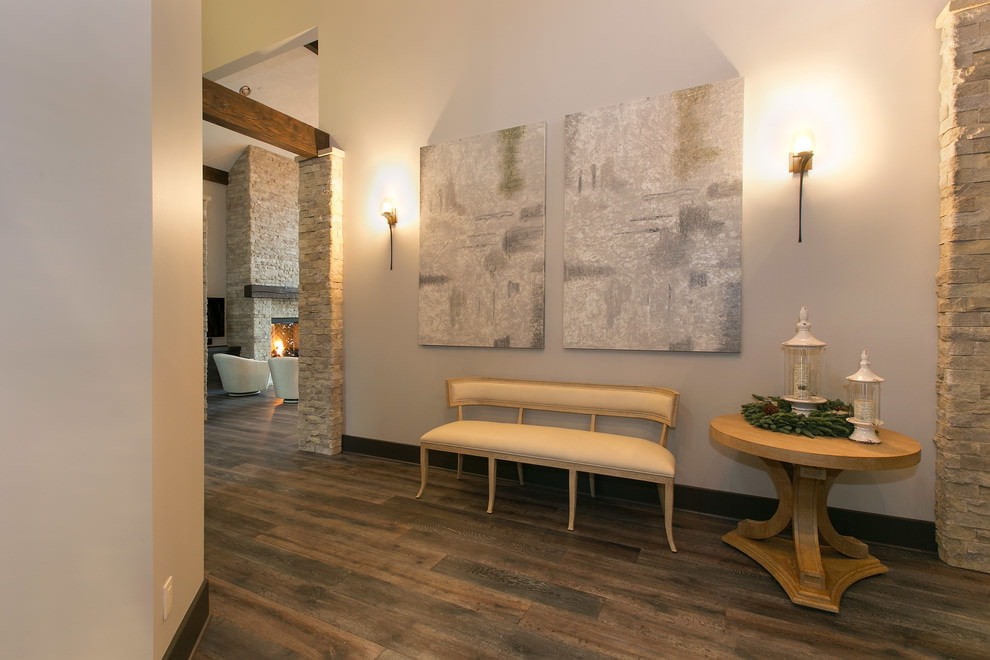
The stone will help to recreate the atmosphere of a medieval castle, make your hallway unique in its kind.
Another plus is a small mass. Compared to natural material, decorative stone is very light and, in part, is easy to install. It is not necessary to further strengthen the walls, the decorative stone is firmly fixed with a special adhesive.
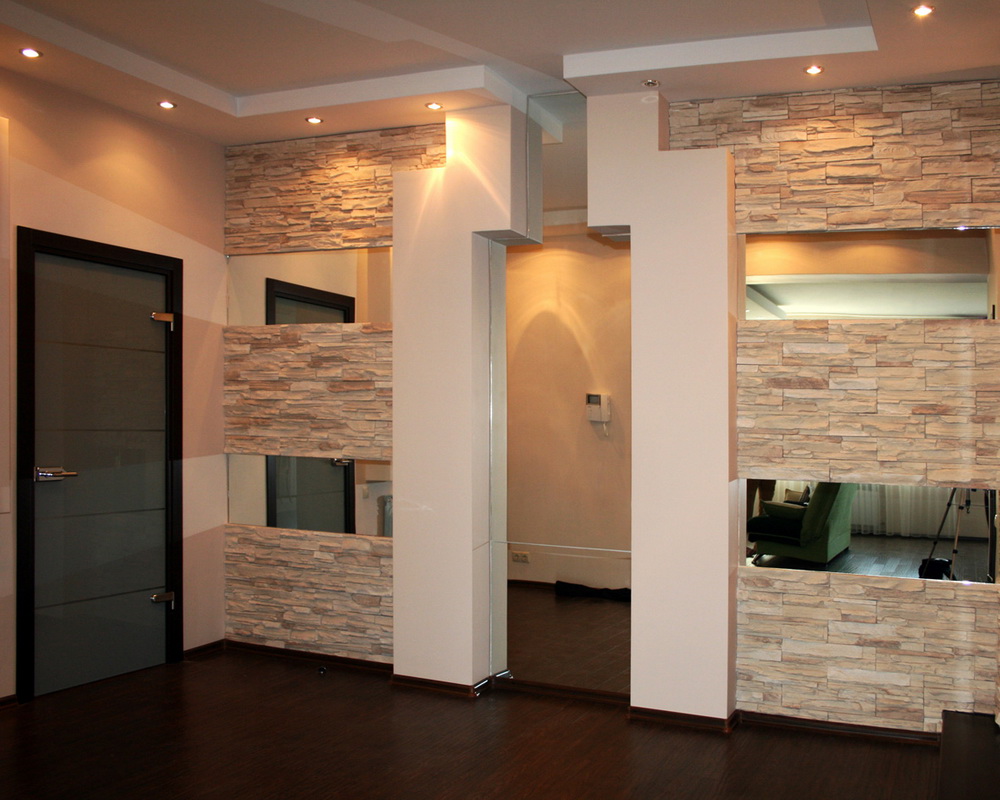
Today, most designers recommend decorating the halls in an unusual way, covering the walls with wallpaper and decorative stone.
Long service life is another bonus to lovers of decorative stone. With proper operation, this finish lasts up to 15 years. Finally, he feels quite comfortable in different areas of interior design, combines perfectly with both wallpaper and wood, creating unique options.
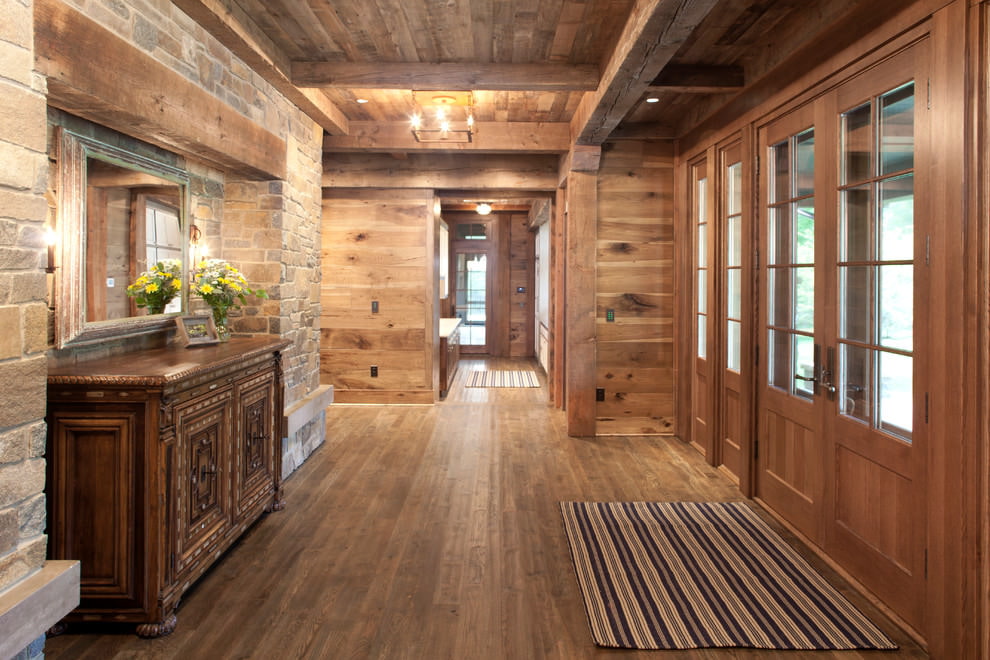
This method of decoration can be applied not only in the hallway, but also in the hallway of the corridor, as it looks beautiful and fits any style.
For finishing work, different types of artificial stone are used:
- gypsum;

It has a low cost, which plays an important role when choosing a finishing material.
- based on cement;

This material has excellent performance, fire resistance and low cost.
- from agglomerate.

The technologies for manufacturing artificial stone are constantly being improved, and from a distance the difference between it and natural stone is almost not visible.
Each has its own advantages and disadvantages.
Gypsum plaster
The most budget option for lovers of decorative stone. But, as often happens, the price is consistent with quality. Gypsum - the material is quite brittle and will easily crack under external influences. But with a competent combination of wallpaper and decorative stone, it has a right to exist in your hallway. The main thing is to place it where there is less chance of mechanical stress.

It is very light, coloring pigments are added during production, which allows you to copy externally natural stone or choose an absolutely unexpected color.
Another disadvantage of gypsum stone is its ability to absorb moisture and collapse as a result of this. You can solve the problem by first applying a special varnish coating to the walls, which will protect both walls and stone from moisture.
Cement based
This is a more expensive option, guaranteeing a long service life and excellent external characteristics. But it is much heavier than the previous one, which means that in order to do quality work in the hallway, you need to hire professional craftsmen who will carry out finishing work at a high level.

Artificial stone, which is molded in molds (usually a mixture of cement, aggregates and iron oxides), can be much lighter than natural.
Another caveat: cement takes time in order to provide the necessary strength. On average, this period takes about a month. All this time, the products are stored in a warehouse, which requires additional costs.
Agglomerate Stone
A relatively new finishing material is a mixture of marble, granite and quartzite. To give the stone the necessary shape, resin or cement is added to the “stone chips”. This decorative material is made in different colors, since dyes are added to its composition.

It does not make walls heavier and easier to install on your own.
Color, size, texture
Choosing the color and size of the artificial stone for the hallway, one must take into account the presence (or absence) of natural lighting, the size of the room and the features of operation.
Varieties of stone:
- Butovy. It looks like boulders or pebbles.

This decorative stone has a stylish and beautiful appearance.
- Chipped stone. It creates the impression of a raw breed.

In order to get expressiveness and unusual contours, it is important to give the material some strokes when designing it.
- Sawn. It has clear geometric shapes and a rough surface.

The masonry will become voluminous if it is not distinguished by a contrasting contour, and spotlights will help to effectively emphasize the lining.
- Mosaic. It consists of stones of different sizes and shapes, forming a finished picture or ornament.

In order to complete the composition in the hallway, it must be decorated with various accessories, mirrors and plants.
- Brick. The most common option, resembling brickwork in appearance.

Masonry must be done with seams or close, and grouting is done to a tone contrasting with the main color of the finish.
- Tiled. Masonry with polished surface.

The entrance hall is that room which should look especially, therefore it is worth choosing an original style for it.
- Fantasy. Variations on the theme of non-existent stones in nature.

Decorative stone veneers are designed for interior walls or fireplaces.
Choosing stone trim for the hallway, you need to pay attention to the location of the lamps. A classic chandelier on the ceiling is not the most suitable option, but the lighting on the wall will make the room spectacular and comfortable.

In the dark, you can use a partial finish, for example one wall or corners.
If the dimensions of the hallway allow, place large green plants on the floor. This addition will enhance the impression of an unusual decoration.

For the classic style, laying a stone not only on the walls, but also on the floor or columns, will be an excellent option.
We use decorative stone: what to consider
First of all, it is important to remember that if the stone (no matter, decorative or natural) is decorated with walls from top to bottom, the feeling of a basement will invariably arise.
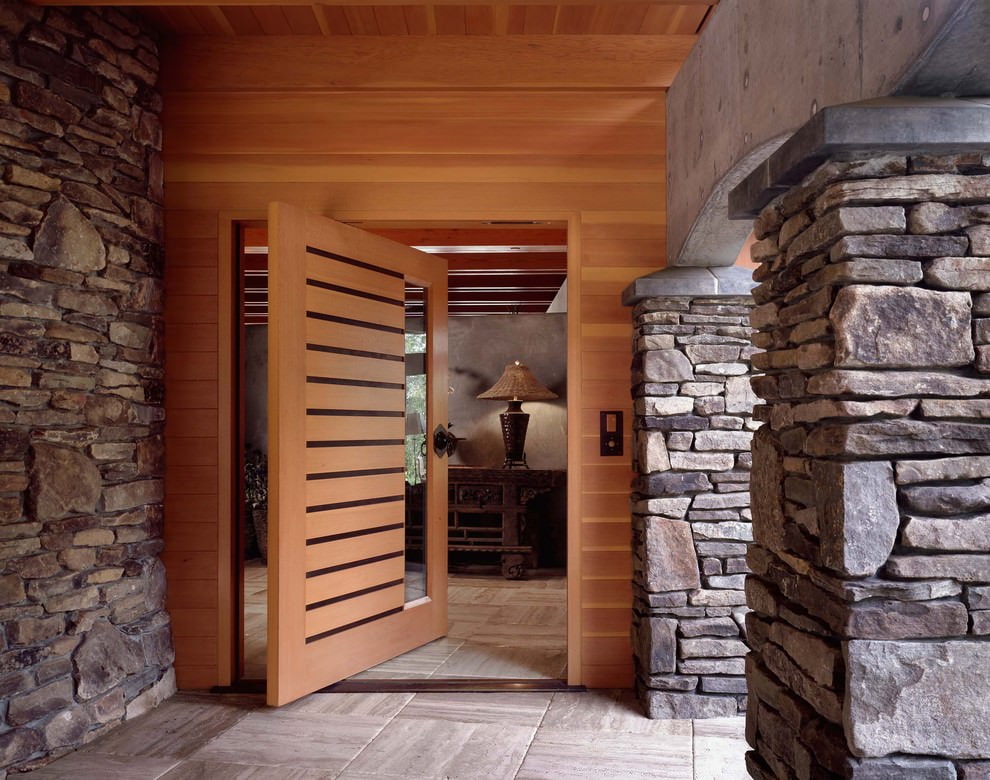
It is important to determine in advance how you will "embed" stone fragments in the overall interior.
A very common option is the decoration of the space near the doors. Also, under the stone, you can arrange part of the wall as a decorative element. In this case, it would be nice to place shelves on the wall, or highlight a “stone fragment” using a drawing or application, emphasizing the uniqueness of the interior solution.

Decorative stone is available in different versions: in the form of separate stones or whole blocks, it will not be difficult to finish in any volume.
When choosing a wallpaper for decoration “in duet” with a stone, follow a simple rule: the color of the wallpaper either repeats the color of the stone, or contrasts brightly with it. Wallpaper material is selected solely on the basis of your preferences. The most budget option, it is not the most wear-resistant - paper wallpaper.
For a more effective appearance and a long service life, prefer non-woven or glass wallpaper. Due to the porous structure, non-woven wallpaper perfectly conceals irregularities and errors on the surface of the walls, and this greatly facilitates the work. In addition, non-woven wallpaper is highly durable and easily painted. So if you wish, you can easily change the color scheme in the hallway and update, thus, the boring interior.

Natural stone is massive, it will be replaced by decorative material, wallpaper or tiles with imitation.
Finally, murals work well with stone trim, especially if the plot is chosen correctly. Such a "symbiosis" allows you to create unique beauty interiors.

Wall murals recreate absolutely any image. With their help, you can emphasize the theme of the hallway of the room.
Wood is another material that stone favors. This community is a true unity of opposites: on the one hand, a cold stone, and on the other - a warm, almost living tree.

The atmosphere in such hallways is surprisingly harmonious.
Obviously, due to the variety of finishing materials, unique in terms of beauty and comfort interiors are created. And even if you've never used anything like this before, take a chance! Believe me, decorative stone will make the hallway special.
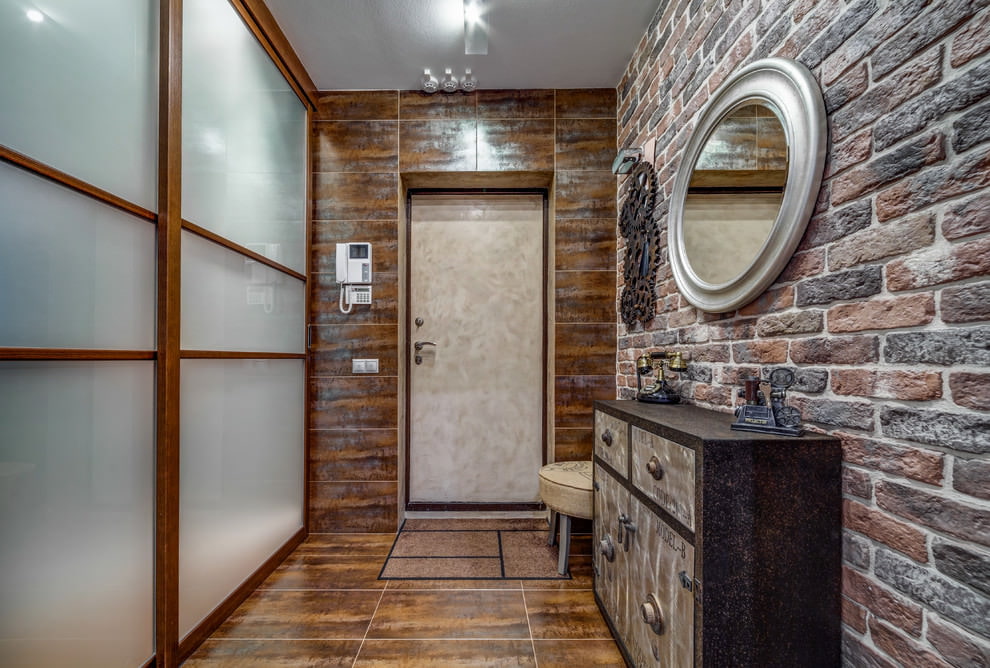
The house begins with the entrance hall, interior decoration with stone will become a stylish and unusual solution.
VIDEO: Decorating the hallway with decorative stone.
















